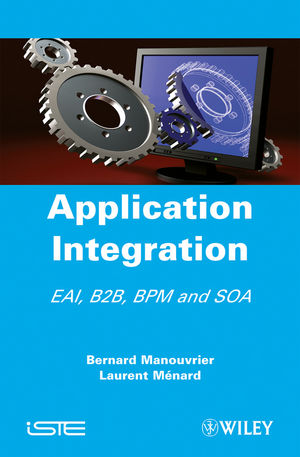Application Integration: EAI B2B BPM and SOAISBN: 978-1-84821-088-2
Hardcover
242 pages
September 2008, Wiley-ISTE
 This is a Print-on-Demand title. It will be printed specifically to fill your order. Please allow an additional 10-15 days delivery time. The book is not returnable.
|
||||||
Foreword xiii
Chapter 1. Introduction 1
Chapter 2. What is Application Integration? 5
2.1. The economy: the “engine” of integration 5
2.2. The history and the issues of application integration 6
2.3. Consequences for IT 12
2.4. Integration typologies 14
2.4.1. Classifying the integration problem types 14
2.4.2. Classifying the applications 19
2.5. EAI: Integrating enterprise applications (A2A) 22
2.5.1. Accounting interpretation: EAI precursor 22
2.5.2. EAI today 23
2.6. Integrating inter-enterprise exchanges (B2B) 24
2.7. Coupling A2A and B2B: A2B (or Business Collaboration) 25
2.8. Managing business processes (BPM) 25
2.9. Service-oriented architectures (SOA) 26
Chapter 3. Levels in Integration Services 29
3.1. Transport and connectivity 30
3.1.1. Defining partners 30
3.1.2. Data transport 32
3.1.3. Connectivity 42
3.1.4. Supervising transport 50
3.2. Adapting the information 52
3.2.1. Transformation 52
3.2.2. Routing 62
3.2.3. Storage 65
3.2.4. Defining the rules 66
3.2.5. Supervising exchanges 70
3.3. Automating business processes 73
3.3.1. Modeling business processes 73
3.3.2. Executing business processes 86
3.3.3. Supervising business processes 88
3.4. Business process and integration: mediation and exchange 90
3.4.1. Business process level and integration level 90
3.4.2. Mediation process sub-level 91
3.4.3. Exchange process sub-level 91
3.4.4. Interaction between the sub-levels 93
3.4.5. Interaction between integration and business process (BPM) 93
3.5. Choosing the exchange architecture 94
3.5.1. Synchronous/asynchronous communication 95
3.5.2. Architecture: centralized or distributed? 95
Chapter 4. Types of Integration Projects 99
4.1. Integrating a single application 99
4.1.1. Exchange cartography 99
4.1.2. The integration platform 101
4.2. IT infrastructure projects 104
4.2.1. Urbanization of information systems 104
4.2.2. IT exchange infrastructure 106
4.3. Integrating inter-enterprise exchanges 111
4.3.1. Exchanging electronic documents (EDI) 112
4.3.2. XML standards 113
4.3.3. Inter-enterprise “spaghetti” system 116
4.3.4. Inter-enterprise exchange platforms 118
4.3.5. “Single Window” initiatives 123
4.4. Managing business processes 127
4.4.1. Points of departure 128
4.4.2. BPM project opportunity: choosing the processes 130
4.4.3. The “top-down” approach 131
4.4.4. Expected results 133
4.5. Implementing a service architecture 134
4.5.1. Characteristics of an SOA 137
4.5.2. Elements of an SOA infrastructure 141
4.5.3. Applicable norms and standards 142
Chapter 5. Application Integration Tools 145
5.1. Brokers 145
5.2. Application servers 146
5.3. Enterprise Service Bus (ESB) 148
5.4. BPM tools 148
Chapter 6. Understanding Integration Failures 151
6.1. High failure rates 151
6.2. The technological approach 152
6.2.1. New technology or new packaging? 152
6.2.2. Technology confronts reality 153
Chapter 7. Integration Myths 155
7.1. The mirage of the single tool 155
7.1.1. A conservative choice: example and consequences 156
7.1.2. “Modern” architectural choice: example and consequences 157
7.2. XML: miracle format 157
7.3. Business adapters: simplifying the implementation 158
7.3.1. Business adapter: implementation – maintenance – problem 160
7.3.2. By way of a conclusion on business adapters 161
7.4. Java: the proof of a modern solution 162
7.4.1. The real reason for Java 162
7.4.2. Limitations of an all-Java integration solution 163
7.5. Files: the “poor cousins” of application integration 163
7.6. Process and services are everything 164
7.6.1. BPM and SOA: top-down approach – from business to IT 165
7.6.2. EAI and B2B: bottom-up approach – from IT to business. 166
7.6.3. Complementary approaches 166
Chapter 8. Integration and IT Urbanization 167
8.1. IT urbanization review 167
8.2. Limits of urbanization without an integration solution 169
8.3. How do integration solutions support IT urbanization? 169
8.4. Limits of integration solutions without IT urbanization 170
8.5. How does IT urbanization support integration solutions? 170
8.6. The need to correlate integration solutions and urbanization 171
Chapter 9. Choosing an Application Integration Solution 173
9.1. General approach 173
9.2. Methodology for calculating return on investment (ROI) 173
9.2.1. Introduction to the method 173
9.2.2. Equations: maintaining the language of integration 176
9.2.3. Operational workload gains through centralized supervision 178
9.2.4. Quality of service improvements 179
9.3. Opportunity study 181
9.3.1. Analyzing the real needs of the enterprise 182
9.3.2. Real needs and the “state of the art” 182
9.3.3. Identifying possible business benefits 183
9.4. Go/NoGo from General Management 183
9.5. The search for a candidate: Request for Information (RFI) 184
9.5.1. Why issue an RFI? 184
9.5.2. Key points in an integration RFI 184
9.6. Request for Proposal (RFP) or specifications document 185
9.6.1. Interest and spirit of an RFP 185
9.6.2. Myths: standard questionnaire + one-stop supplier 185
9.6.3. Key points in an RFP for application integration 186
9.7. Presentations from the candidates 188
Chapter 10. Deployment Methodology 189
10.1. Introduction to the method 189
10.2. Deployment methodology: general principles 190
10.3. Special case: deploying BPM and SOA 192
10.4. Economic models of cost allocation 192
10.4.1. Cost allocation linked to usage 192
10.4.2. Cost allocation linked to usage and services (developed model) 195
Chapter 11. Operational Examples of Implementation 203
11.1. Rationalizing bonds purchase order management (banking) 203
11.1.1. The context 203
11.1.2. The choices204
11.1.3. The solution 205
11.1.4. The results 206
11.2. An EAI hub (telecommunications) 207
11.2.1. The context 207
11.2.2. The choice 207
11.2.3. Implementing the pilot: first difficulties 208
11.2.4. Integration tests: disturbing results 209
11.2.5. How did we end up here? Consequences of architectural choices 209
11.2.6. Performance tests: catastrophic results 210
11.2.7. Report card: final decision 210
11.2.8. The lesson: what we could have done 211
11.3. A2A and B2B (retail) 211
11.3.1. The context 211
11.3.2. The choice 212
11.3.3. The solution 212
11.3.4. The results 213
11.4. BPM and SOA in service delivery 213
11.4.1. The context 213
11.4.2. The choice 214
11.4.3. The solutions 214
11.4.4. The results 215
11.4.5. Points to watch for this type of solution 216
Conclusion 217
Bibliography 219
Index 221



